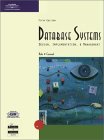
The primary objectives of the various chapters dealt with in the textbook either in lectures, or practicals, are highlighted below. With regards to practicals, everything covered should be considered as examinable. It is suggested that you review your solutions and compare them with the model solutions provided. This is based on the prescribed textbook
"Database Systems: Design, Implementation, and Management, Fifth Edition" by Peter Rob and Carlos Coronel. In Summary, chapters 1 to 6, 9, 13 and 14 will be covered.
CHAPTER 1
File Systems and Databases
Primary Chapter Objectives
- To develop the main database system concepts.
- To show the evolution of database systems from computer file systems.
- To show that database design is a crucial first step in the development and proper use of database systems.
- To understand the main DBMS functions.
- To describe the database environment.
- To introduce the student to the basics of different types of database systems.
CHAPTER 2
The Relational Database Model
Primary Chapter Objectives
- To learn the basic relational database components and concepts.
- To become familiar with the relational table's components and characteristics.
- To learn how keys are used in the relational database environment.
- To introduce the relational database operators.
- To develop a simple data dictionary.
- To examine basic entity relationships.
CHAPTER 3
Entity Relationship (E-R) Modelling
Primary Chapter Objectives
- To learn what a conceptual model is and what its purpose is.
- To learn the difference between internal models and external models.
- To learn how internal and external models serve the database design process.
- To learn how relationships between entities are defined and refined, and how such relationships are incorporated into the database design process.
- To learn how ERD components affect database design and implementation.
- To learn how to interpret the modeling symbols for the four most popular E-R modelling tools.
- To learn that real-world database design often requires you to reconcile conflicting goals.
CHAPTER 4
Normalization of Database Tables
Primary Chapter Objectives
- To learn to identify good and poor table structures.
- To learn that poor table structures can be repaired through normalization.
- To learn normalization techniques.
CHAPTER 5
Structured Query Language (SQL)
Primary Chapter Objectives
- To learn the SQL data definition: CREATE.
- To learn the basic SQL data management language: INSERT, UPDATE, and DELETE.
- To learn the basic SQL data querying language: SELECT.
CHAPTER 6
Database Design
Primary Chapter Objectives
- To learn what an information system is.
- To learn what a Database Life Cycle (DBLC) is.
- To learn what a Systems Development Life Cycle (SDLC) is.
- To demonstrate the relationship between the DBLC and the SDLC.
- To learn how database design fits into the design of an information system.
CHAPTER 9
Transaction Management and Concurrency Control
Primary Chapter Objectives
- To learn what a transaction is.
- To learn how an incomplete transaction can yield an inconsistent database.
- To learn how an inconsistent database can be avoided through proper transaction management.
- To learn what concurrency control is.
- To learn how concurrency control failure affects a database.
- To learn how concurrency control is accomplished.
- To learn what database recovery management is.
- To understand the use of transaction logs in recovery management.
CHAPTER 14
Databases in Electronic Commerce
Primary Chapter Objectives
- To learn the definition for e-commerce, and its importance in the current business environment.
- To learn some of the benefits and the disadvantages of e-commerce, as it currently exists.
- To learn the major security and privacy issues that relate to e-commerce.
- To learn how payments for purchases are handled in e-commerce.
- To learn the requirements for e-commerce databases.
- To learn the definition of XML and its importance in e-commerce.
- To learn how DTD and XSD documents fit into the e-commerce environment.
 The primary objectives of the various chapters dealt with in the textbook either in lectures, or practicals, are highlighted below. With regards to practicals, everything covered should be considered as examinable. It is suggested that you review your solutions and compare them with the model solutions provided. This is based on the prescribed textbook "Database Systems: Design, Implementation, and Management, Fifth Edition" by Peter Rob and Carlos Coronel. In Summary, chapters 1 to 6, 9, 13 and 14 will be covered.
The primary objectives of the various chapters dealt with in the textbook either in lectures, or practicals, are highlighted below. With regards to practicals, everything covered should be considered as examinable. It is suggested that you review your solutions and compare them with the model solutions provided. This is based on the prescribed textbook "Database Systems: Design, Implementation, and Management, Fifth Edition" by Peter Rob and Carlos Coronel. In Summary, chapters 1 to 6, 9, 13 and 14 will be covered.